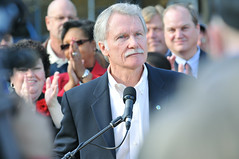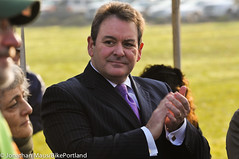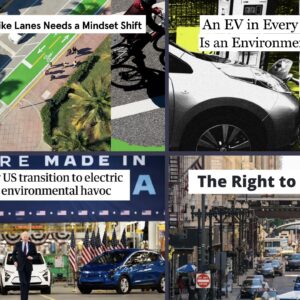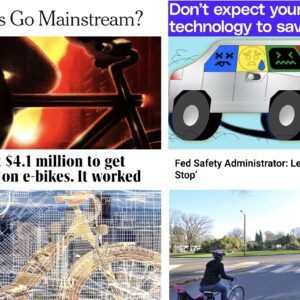“The big lesson here is, we don’t need massive and costly road capital projects.”
— Governor Kitzhaber in 1997 after a 6-day closure of the I-5 bridge didn’t result in the massive traffic jams everyone predicted.
The effort to resurrect the Columbia River Crossing project is making our heads spin. While citizen activists and non-profit groups who are against the project make last-ditch efforts to contact their legislators and try to not make the mistakes they made last time, the powerful forces that rammed the project through Salem last March are up to their same old tricks. Meanwhile, high-profile critics of the project are doing their best to snuff it out.
While we’ve never attempted blow-by-blow reporting of this issue (I recommend The Columbian and the Willamette Week for that), there are a few things that have come across my desk recently that I feel are worth sharing…
The first is a quote from Oregon Governor John Kitzhaber that shows just how far he’s come in his thinking about the merits of investing billions of dollars into massive highway expansion projects. The quote was found by reader Peter Welte and it came from a fascinating article (given the current CRC discussion) published in The Oregonian on September 23, 1997 titled, Closure of I-5 bridge demonstrates transit’s value.

massive highway expansion projects governor?
(Photo © J. Maus/BikePortland)
The set-up for the article is the classic “carmageddon” scenario we’ve seen play out recently in Los Angeles and elsewhere. Facing a multi-day closure of a major freeway, officials prepped for the worst. In this case, “traffic jams as long as 40 miles.” But as it turned out, people simply changed their habits and the result was “the evaporation of traffic.” That phenomenon spurred some amazing quotes from Kitzhaber and local officials in Vancouver.
Here’s what the City of Vancouver’s traffic engineer said at the time:
“I think that this has shown that there is an incredible amount of capacity in our existing system, should people decide to use it in a different way than they’re using it today.”
And Governor Kitzhaber (yes, he was governor back then too) — who has been pushing hard for the CRC — had this to say:
“The big lesson here is, we don’t need massive and costly road capital projects.”
Our next item is also noteworthy for its word choices.
Check out this interesting event coming up at the Red Lion on Hayden Island next month. The event, which will be co-presented by the City Club of Portland and the Columbia Corridor Association (a non-profit that promotes freight and trade) is dubbed, The New Columbia River Crossing. The format looks to be an informal discussion led by Oregon Department of Transportation Director Matt Garrett. Garrett is a firm believer in the CRC who has carried ODOT’s water on the project for many years.

rather not rehash the past
when it comes to the CRC.
(Photo © J. Maus/BikePortland)
The fact that Garrett going out in the public to extoll the virtues of the project isn’t surprising. What surprises me about this event is the language used to promote it and the fact that it’s not scheduled to happen for another month.
Here’s how event organizers set the context (emphases mine):
The Columbia River Crossing (CRC) is a massive planning effort to accommodate the needs and wishes of commuters, mass transit riders, bicyclists, and freight haulers in one earthquake-safe crossing on a budget. That would be a lot to ask, even if it didn’t also involve the Coast Guard, an historic airfield and your usual assortment of advocates and politicians. It’s little wonder that the project has stumbled.
Regardless of what happens to the CRC we all know, there’s a need to improve this weakest link in the entire interstate highway system. What will those improvements look like? How can we insure the conversation between Vancouver and Portland will be productive? Join us for a look forward, with no rehashing of the past.
Wow. It’s as if whoever wrote this (and it was almost surely OK’d by Garrett and ODOT) is already making excuses and covering their butts for all the money wasted in planning the project. I find it fascinating they would try to dismiss/excuse the failures of this project has even after spending $200 million or so in taxpayer money on consultants and planning. And the “regardless of what happens” and “a look forward” parts make it appear to me that insiders like ODOT, the CCA and Garrett are already starting to work on the project’s post-mortem spin.
And remember, if you attend, there’s a “no rehashing of the past” rule which means Garrett would rather not speak to any of the shenanigans or controversy that have hung around the neck of this project for years.
As for scheduling the event for October 23rd, that too seems odd given that project backers themselves had initially claimed September 30th was the deadline for action (although that has been pushed back a bit now). The language of the event flyer, combined with this date, sure makes it seem like ODOT and other pro-CRC forces are adjusting their tactics from supporting a project, to supporting a positive narrative about a failed project that makes them look less bad for being on the losing side.
Of course, my entire analysis of this could be a failure too.
And finally today I wanted to share some actual news and recent reporting. The Willamette Week has done a great job following the big pieces to the story. Their latest on what Oregon State Treasurer Ted Wheeler thinks about the project is a must-read.
Stay tuned. Hopefully we’ll know the ultimate fate of the CRC in the next few weeks.







Thanks for reading.
BikePortland has served this community with independent community journalism since 2005. We rely on subscriptions from readers like you to survive. Your financial support is vital in keeping this valuable resource alive and well.
Please subscribe today to strengthen and expand our work.
Wow, that Oregonian article from 1997 is a real gem.
Some would instead, bold face:
“…there’s a need to improve this weakest link in the entire interstate highway system. What will those improvements look like? How can we insure the conversation between Vancouver and Portland will be productive? …” excerpt of intro for upcoming City Club of Portland event
The above statement and questions, address the reality of the CRC project design that to date has been a dilemma.
Most likely, there will at least, need to be substantial money spent on the crossing in the form of refurbishment of the existing bridges, or upgrades to them to resolve river shipping navigational issues. And still, possible demolition of the current bridges, to be replaced by a new design that better and more reliably can meet needs anticipated for the future.
Weakest link in the ENTIRE interstate freeway system?! First, the claim is untrue. Second, it’s torn right out of the CRC talking points.
This city club “discussion” seems to be lacking integrity and balance. Is it basically seems to be another CRC dog and pony show.
We should expect better from the City Club.
“Weakest link in the ENTIRE interstate freeway system? …” subsidizers anonymous
Equivocating on whether the I-5 bridges are or aren’t the ‘weakest’ link in the entire interstate freeway system doesn’t cancel other reasons essentially requiring that money be spent on the I-5 river crossing.
The current bridges are old and of questionable structural integrity. Their design generally seems to be considered not sufficient for needs of today or going into the future. The CRC I-5 bridges, while perhaps not the weakest link in the interstate freeway system, most certainly are a link…and a key link at that, of the interstate freeway road traversing the river between two states.
Replacement of the existing bridges with a new bridge may continue to be put off…for how long, nobody can be quite certain…but in the meantime, most likely, more money will have to be dumped into their maintenance or upgrade. It’s a question of which way is the money best spent. Taking this approach, or build an entirely new bridge.
Bob,
“The massive Interstate 5 bridge and freeway project is a “political necessity” to persuade Clark County residents to accept something they previously didn’t want—a MAX light-rail line from Portland to Vancouver. (To read the Feb. 16, 2012 Oregon Supreme Court decision regarding the Columbia River Crossing Project and the corresponding Willamette Week article that proves this go here: http://www.wweek.com/portland/article-18881-the_$25_billion_bribe.html
Don’t let the CRC mongers fool you.The bridge replacement is a tertiary, at best, reason for this project. By the way, most of the bridges around here should be replaced on those grounds. Is that really what we want to be doing? Preemptively replacing every bridge around here because it’s not modern (and ugly enough) and could collapse in an earthquake? We simply don’t have the funds for that. If we did, a better mitigation would be paid to Oregon’s energy hub on the Willamette http://www.oregonlive.com/environment/index.ssf/2013/09/oregons_energy_hub_on_the_will.html or all the old brick school buildings that will crumble and crush our children.
Will it suck if the I-5 collapses in remote event of an powerful earthquake in it’s 60-years remaining (according to ODOT) lifespan? Yes, but don’t forget the death tolls will be lower than the catastrophes mentioned above and remember there is a replacement bridge just upriver.
You know, the Glenn Jackson Bridge. Once Oregonians were told that bridge would solve the congestion, and freight problem, too. Seems it only created east Vancouver.
So please, please, please, please, please, please take the-bridge-needs-replacing-so-we-have-to do-the-CRC argument off the stinking, bloody table. It’s just not true. It’s nothing but a red herring. Argument over, go to jail, do not pass go, do not collect 200 million dollars!
Dan…thanks for a reply with at least some thought expressed in it.
“…Preemptively replacing every bridge around here because it’s not modern (and ugly enough) and could collapse in an earthquake? We simply don’t have the funds for that. …” Dan Kaufman
The I-5 bridges aren’t just any river crossing. They’re a key crossing for the Interstate Hwy system. Their age and seismic resistance capability is just one of many reasons possible replacement of the bridges continues to be considered.
Also a reason, cited by active transportation advocates, is that it’s not felt that the current bridges adequately provide for walking and biking across the bridge, something a new bridge could be designed to do, but that likely couldn’t be easily or economically done with the existing bridges, at least not in a manner that people paying the bills seem to be likely to accept.
Watching the news and listening to people, impression I get, is the general public doesn’t have a very good idea of what they want or expect from this river crossing, whether from the existing bridges, or built new.
wsbob,
no need to dismiss Dan’s reply ‘…with at least some thought expressed in it…’ He’s right, and the CRC talking points don’t make any more sense when you repeat them than when Garrett or McCaig or Kitzhaber do.
wsbob – “in the meantime, most likely, more money will have to be dumped into their maintenance or upgrade. It’s a question of which way is the money best spent. Taking this approach, or build an entirely new bridge.”
wsbob – “ODOT is accountable to the demands of the public”
http://bikeportland.org/2013/08/19/barbur-hit-and-run-renews-calls-for-odot-action-92523#comment-4390920
wsbob – “It’s the public’s money, not ODOT’s. ODOT is entrusted to spend the public’s money it has in its budget wisely, but the question is whether the public would consider such an expense to be wise.”
http://bikeportland.org/2013/08/19/barbur-hit-and-run-renews-calls-for-odot-action-92523#comment-4392039
It is hard to read anything from Matt Garrett or wsbob on this topic with a straight face. The idea that the course ODOT is pursuing w/r/t the CRC is wise, fiscally prudent, or reflects any effort on their part to channel public sentiment is farcical.
Thanks, Jonathan, for another grim if astute bit of analysis on this topic.
watts…thanks for the quotes and links to some of my earlier comments. Good for them, whoever reads them, but I’m doubtful many, if any will.
“…The idea that the course ODOT is pursuing w/r/t the CRC is wise, fiscally prudent, or reflects any effort on their part to channel public sentiment is farcical.” 9watts
Explain.
I think I’ve mostly said this already, but since you asked:
wise –
well the days of autodom’s reign are numbered (climate change, peak oil, price of asphalt, insolvency, VMT decline). The CRC as presented is premised on its indefinite continuation, even expansion.
fiscally prudent –
ODOT/the state/everyone is already paying interest on loans & bonds we’ve taken out to build, maintain existing infrastructure. The fiscal implications of going down the CRC route are on top of all of this. Others have said this better than I can, but 30 years of interest on this thing that is mostly freeway interchange expansion is not something we can well afford.
effort to channel public sentiment –
Well, where to begin? Jonathan’s outlined it well already, I think. In the midst of a sea change in attitude by NGOs, legislators, and others, ODOT’s once again out in front attempting to rescue this dragon, carry it forward. I think we pretty well understand that this whole effort stems from political machinations at a high level over decades, and ODOT’s acquiescence, championing, water carrying suggest complicity at the very least. Do you really think the public would be keen on this if they understood what Ted Wheeler and Joe Cortright are trying to tell us?
What I’m reading from this particular bikeportland story about ongoing discussions having to do with a potential I-5 CRC project design, is that a final decision to proceed with any particular design for a new bridge across this river point, has not been made.
Also, that the City Club will soon have an event in which questions about improvements to the I-5 CRC crossing, and conversation between Vancouver and Portland about them, will be addressed. While, no doubt, a replacement bridge could continue to be an option preferred by some people, there’s no mention, in the City Club event notice excerpt bikeportland’s publisher-editor cited in this bikeportland story, of a replacement bridge.
The key word from that excerpt, relating to what changes to the I-5 CRC crossing will be inquired about and discussed, is ‘improvements’. The message has been conveyed, that there’s likely not sufficient support for the mega-freeway interchange and light rail project that a proposal and some design work has been drawn up for. As a result, ODOT apparently isn’t necessarily advising upon proceeding with only that proposal, as some people seem to assume.
That still leaves the question of what to do, going into the future, with the existing I-5 CRC crossing: simply maintain the existing bridge infrastructure…or…upgrade the bridge structures there now. Or, something else.
Answers to these questions are what people going to and participating in the upcoming City Club event ought to devote their energies to. In fact, people in the entire metro area ought to be discussing more amongst themselves, what they feel should be done with this very important, state to state river crossing.
By the way…you failed to explain the statement you made. I was fairly sure you couldn’t, or wouldn’t.
wsbob,
this boils down to a basic difference in how we look at this situation. You seem to take ODOT and the City Club’s statements at face value; assume their motives are pure and that public input is not only valued but will somehow affect the outcome. I can’t explain your credulousness. I’m with Ron Buel.
http://bikeportland.org/2013/02/28/as-crc-rumbles-forward-major-advocacy-groups-sit-on-the-sidelines-83284#comment-3801482
and
http://bikeportland.org/2013/02/28/as-crc-rumbles-forward-major-advocacy-groups-sit-on-the-sidelines-83284#comment-3801575
for starters
I must not have read that particular bikeportland article about the CRC, because I don’t remember those comments from Ron Buel…so, thanks for those links.
What he had to say is nothing new, but worth keeping in mind. Nothing that isn’t rather commonly understood about how partisan politics, and lobbyists work. I’m afraid, at least in his comments you’ve provided the links to, he appears to be a fatalist, someone that’s mostly given up believing that ordinary working people can have much of an affect on the outcome of big decisions made in the state.
Maybe he forgets that not just a few ordinary working people are represented in part by some of the groups, for example, labor, some of whose actions he objects to.
At any rate, no specific proposal for how to deal with the I-5 CRC, now, or for the next 60 years or so (the period of time Dan Kaufman up there a piece, suggested is considered the remaining life of the current bridges.), is yet a done deal. In fact, it seems to be a long way from such a deal. Now’s the time for anyone that’s interested and able, to get in there and make clear, exactly how they think proceeding with the I-5 CRC should go from this point on.
“someone that’s mostly given up believing that ordinary working people can have much of an affect on the outcome of big decisions made in the state.”
Well said. What makes you think otherwise? Can you point to an example where you feel like ordinary working people had an effect (since the iconic Mt Hood Freeway)? Do you feel like the Oregon legislature listens to unmonied constituents when it comes to these issues?
I have no doubt that ORGANIZED ordinary working people can have an effect, but the hurdles are high, and everyone has lots of responsibilities & competing demands on their time and energy. We’re up against the Patricia McCaigs and the rest, who get paid big bucks to find ways to circumvent what ordinary folk may prefer to have done with our tax money.
Examples are everywhere. There regularly, are open public meetings conducted locally and statewide. Many decisions are drawn out over long periods of time, largely for the purpose of including the public’s viewpoint on the issues. In fact, I believe public input is one of the reasons plans on how to proceed with the CRC have been drawn out for so many years, and why it looks like they’ll be drawn out even longer.
wsbob,
you are conflating a *process* for soliciting public input with any sincere inclusion of that input. Let me give an example: in 2006, Metro contracted out a large effort to solicit public input in the course of revising their Solid Waste Reduction plan. 300 pages of responses were received and turned into a pdf which can be viewed online. All very impressive, especially if like me you read the responses and discovered how thoughtful and detailed many were. The trouble ? *None* of it was incorporated into the policy. Not a single one of the dozen or so major points that had been identified before the public input phase was altered or adjusted in response to the public input. Given ODOT’s track record I have no reason to think this would be any different in their case.
I am surprised Clark County, with it’s strong libertarian streak, doesn’t have an initiative in the works to make it against the law to allow the state county to accept the bridge on their land, or something to that effect. I thought they passed one to prevent C-Tran from funding MAX construction/operation. I am loosing track!
I hope those tea-party types freak out enough to stop it, because opposed Portlanders don’t have as much pull as special interests in Oregon.
I don’t think Garrett’s October 23rd event is about shaping the narrative of a failed poject. The so-called September 30th deadline was always fictional. No such deadline for federal funding actually exists, we’d just lose one year, not 6 years as project supporters claim if Oregon committs later this year or early in 2014. At this point, they’re trying to kick the can down the road while they line up support for a project without WA funding. They could pass it in a separate special session later this fall or in the February 2014 session. Or they may kick the can all the way to January 2015 and hope that WA’s 2014 elections will shift the State Senate to support the CRC.
Somehow, project opponents need to stick a stake in this vampire so the kicking the can strategy won’t succeed. My best take at this point is to keep calling your legislators urging hem to block the CRC as an Oregon-led project and hope enough grassroots pressure starts to give pause to the legislators (like House Speaker Kotek) who continue to champion it.
Portland has grown almost 20% in population since 1997, Vancouver a little over 15%. I’d love to see how trips per day over the I-5 bridge have changed.
They’ve declined each year for the last decade.
City Club and ODOT can spin hype all they want. It doesn’t change the fact that Oregon’s bonds expire on September 30th, as clearly stated in HB 2800. That is a real deadline, after which time an entirely new will be have to be voted on, and would require another infuriating, exhausting round of public hearings in Salem.
The 1997 article quote refers to the I-5 Bridge’s Trunnion Repair Project and the massive outreach that all of the partner agencies did to get folks to change their commute practices for the short multid-ay closure. A lot of folks stayed home [from work and shopping], diverted to the I-205 and used the special Amtrak commuter rail service while the project ended sooner than planned.
http://www.rtc.wa.gov/studies/archive/trunnion/brdgnews.htm
http://books.google.com/books/about/Interstate_5_Bridge_Trunnion_Repair_Proj.html?id=pKv8GgAACAAJ
The latter [with regular Amtrak service] is still a nice quick congestion free option to the Pearl District if you do not have a car AND do not mind paying $12 to $24 RT with free parking at the Vancouver station. (It used to be 20 minutes one way but BSNF rail upgrades has pushed to to 50 minutes this fall.)
> It used to be 20 minutes one way but BSNF rail upgrades has pushed to to 50 minutes this fall.
How does a trip jump from 20 to 50 minutes? Construction delays? Will it go back down later?
Seems like a great commuter system if they could get costs down.
Construction delays somewhereon the line from the reservation notes. Yes it could be a commuter line if they added a standing room car/ section vs. seat reservation type service.
Wow…bringing up all this trunnion related memories also dredged up this advisory detour map for cyclists crossing the I-5 Bridge and the Vancouver bikeway network as it was then back in 1997.
http://www.rtc.wa.gov/studies/archive/trunnion/bikemap.htm
Notice the network map does not list any bike lanes…I think the City added our first bike lane in 1999 (August/ September) on Ft Vancouver Way.
off to include a color for “most suitable” routes when there aren’t any on the map…
More in the “inexorably grinding along” folder:
http://www.columbian.com/news/2013/sep/26/c-tran-board-approves-light-rail-financing-plan/
The City Club makes me want to puke.
Great reporting.
In encourage folks to send there concerns to City Club staff:
Sam Adams (sam@pdxcityclub.org) and Rachel Loskill (rachel@pdxcityclub.org)
Why isn’t the City Club holding a forum that includes those (Robert Liberty, Joe Coright, Ron Buel) who have opposed ODOT’s misleading
representations of the problem and the “solution”? Why not host a forum with those (like George Crandall and Jim Howell) who have advocated for solutions different from those advocated by ODOT, CRC staff, and pro-CRC business and labor lobbyists? Critics of the CRC and those who advocated for sensible alternatives have been marginalized too long by ODOT and CRC staff. The City Club should be opening up the discussion rather than providing an opportunity for Matt Garrett to do damage control.
Make an event page and invite all those folks. See if Bike Walk Vote wants to host.
To be fair, the City Club did host an event about two years ago at Jimmy Mak’s that featured Joe Cortright, Jim Howell, and George Crandall.
“…Critics of the CRC and those who advocated for sensible alternatives…” Jim Labbe
Alternatives to the so far front-running bridge design, that apparently not enough people in Washington and Oregon want to build.
Coast Guard just announced permit is approved – 3 year window to start construction before needing to re-apply.
“This weakest link in the entire Interstate Highway System”? According to whom? I’ve heard this parroted over and over, but I’ve never seen anyone provide any evidence of it.
I’ve heard many people say that it’s the worst stretch of traffic along I-5. To that I say: I-5 is one piece of a vast Interstate system. And I say: If you think this is the worst traffic along I-5, you clearly have not driven the entire length of it more than once. There are plenty of bad spots in California (particularly as you drive south of and through the Grapevine). Sacramento is no joyful spot to drive through either. And Seattle? It’s so close to here and it’s so much worse to drive through on the Interstate.
Is Kitz getting a kick down from some WA developers or something? Or bridge construction companies? This is so much money and being pushed so hard with so many untruths it’s starting to stink.
Columbia River Crossing: Tolling questions could scuttle bridge project
http://www.oregonlive.com/business/index.ssf/2013/11/columbia_river_crossing_tollin.html
from the article: “troubled projects have failed, often because planners overestimated traffic.”
I vote for this being a major understatement when applied to future projects such as the CRC. Where are all these future cars and drivers supposed to come from? Never mind overestimates, there will be *no more traffic* by the time/if this thing is ever built.